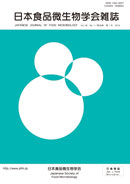Volume 36, Issue 2
Displaying 1-8 of 8 articles from this issue
- |<
- <
- 1
- >
- >|
Review
-
2019Volume 36Issue 2 Pages 75-83
Published: June 30, 2019
Released on J-STAGE: July 01, 2019
Download PDF (486K)
Symposium II: Epidemiology, Food Microbiology, and Pathogenic Mechanisms of Foodborne Streptococcal Infections
-
2019Volume 36Issue 2 Pages 84
Published: June 30, 2019
Released on J-STAGE: July 01, 2019
Download PDF (153K) -
2019Volume 36Issue 2 Pages 85-88
Published: June 30, 2019
Released on J-STAGE: July 01, 2019
Download PDF (676K) -
2019Volume 36Issue 2 Pages 89-93
Published: June 30, 2019
Released on J-STAGE: July 01, 2019
Download PDF (411K) -
2019Volume 36Issue 2 Pages 94-99
Published: June 30, 2019
Released on J-STAGE: July 01, 2019
Download PDF (1154K)
Original
-
2019Volume 36Issue 2 Pages 100-104
Published: June 30, 2019
Released on J-STAGE: July 01, 2019
Download PDF (335K)
Short Paper
-
2019Volume 36Issue 2 Pages 105-109
Published: June 30, 2019
Released on J-STAGE: July 01, 2019
Download PDF (415K) -
2019Volume 36Issue 2 Pages 110-114
Published: June 30, 2019
Released on J-STAGE: July 01, 2019
Download PDF (342K)
- |<
- <
- 1
- >
- >|
